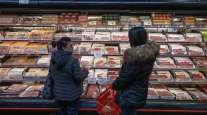Consumer Spending Climbs by Most in Three Months

Consumer purchases climbed in September by the most in three months as incomes grew, signaling momentum in the biggest part of the U.S. economy.
The 0.5% advance in spending, which accounts for about 70% of the economy, followed a 0.1% decline the prior month that was revised lower, a Commerce Department report showed Oct. 31. The median forecast in a Bloomberg survey called for a 0.4% gain.
While the results indicate a solid handoff into the final quarter of 2016, disposable income, or the inflation-adjusted money left over after taxes, was little changed for a second month, indicating wages will need to pick up to boost spending even more. Such support is needed to drive faster economic growth, which picked up last quarter despite softer household purchases.
“We entered the holiday quarter with good support from the consumer,” said Russell Price, a senior economist at Ameriprise Financial Inc. in Detroit. “As long as we continue to see employment growth and wage growth, that’ll put more money in people’s pockets and give them the ability to spend at a faster pace.”
Nominal incomes rose 0.3% after a 0.2% gain.
Inflation-adjusted spending rose 0.3% in September after a 0.2% decline. The advance in purchases included a 1.8% jump in durable goods.
The September figures provide more perspective on how consumer spending was doing toward the end of the quarter. Gross domestic product climbed at a 2.9% annualized rate in the third quarter after a sluggish first half, data showed Oct. 28. Household purchases grew 2.1%, or about half the pace as in the previous three-month period.
For September, forecasts for consumer spending ranged from no change to an increase of 0.6%, according to the Bloomberg survey. The previous month’s reading was initially reported as little-changed.
The Bloomberg survey median for incomes was 0.4%, after a previously reported 0.2% gain.
The savings rate decreased to 5.7% from 5.8%. Wages and salaries rose 0.3%.
The report’s price gauge based on the personal consumption expenditures index, the Federal Reserve’s preferred measure of inflation, rose 1.2% from a year earlier, the most since November 2014.
The core price measure, which excludes food and fuel, increased 1.7% from September 2015. Inflation hasn’t reached the Fed’s 2% goal since 2012.
The Fed’s rate-setting committee meets on Nov. 1-2, and investors see a slim chance for a rate move this week, with a higher probability for December.




